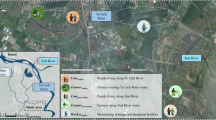Abstract
A study was carried out in a rural area of Asir region in Southwest of Saudi Arabia where information on the types of domestic water supply and sociodemography in relation to intestinal protozoal infections were obtained from 1417 inhabitants (81.4% of the total) of nine villages. Stool samples were collected from the study population and examined for intestinal parasites. Overall, the prevalence rates of infection with the common water-borne parasites,Giardia lamblia andEntamoeba histolytica were 18.9% and 9.2% respectively, which were high compared to other endemic areas of the Kingdom. The sociodemographic factors including age, sex, degree of education, intrafamilial clustering and crowding index were found to be non significant determinants of both protozoal infections. The source of domestic water was the sole factor significantly associated with the high prevalence rates of infection in the community. This relationship was confirmed by multiple logistic regression analysis. A significantly high risk of contracting the infection with both parasites was observed among individuals who drank jar water (OR=2.973, 95%CI:1.515–4.402 and OR=2.831, 95%CI:1.414–3.915, forG. lamblia andE. histolytica respectively) or well water (OR=2.153, 95%CI:1.211–3.913 and OR=2.117, 95%CI:1.341–3.715, forG. lamblia andE. histolytica respectively). Those who used desalinated water for drinking seems to have the lowest degree of exposure to the risk of infection (OR=0.689, 95%CI:0.501–0.849 and OR=0.793, 95% CI:0.518–0.912, forG. lamblia andE. histolytica respectively). The results indicate that the use of improved water supply, including protection of community wells and domestic storage tanks, together with mandatory inspection measures during transportation and distribution of commercial water should reduce the rate of infection with the two protozoal parasites in this rural community.
Similar content being viewed by others
References
Bolbol AHS and Mahmoud AA. Laboratory and clinical study of intestinal pathogenic parasites among Riyadh population.Saudi Med J 1984; 5:159–166.
Al-Madani AA, Omar MS, Abu-Zeid HA, and Abdulla SA. Intestinal parasites in urban and rural communities of Abha, Saudi Arabia.Ann Saudi Med 1989; 9:182–185.
Khan MU, Amir SE, Eid OM, and Aggerwal S. Prevalence of intestinal parasites among patients in the Abha region.Ann Saudi Med 1989; 9:471–474.
Omar MS, Abu-Zeid HA, Mahfouz AAR. Intestinal parasitic infections in schoolchildren of Abha (Asir), Saudi Arabia.Acta Tropica 1991; 48:195–202.
Abu-Zeid HA, Khan MU, Omar MS and Al-Madani A. Relationship of intestinal parasites in urban communities in Abha to socioenvironmental factors.Saudi Med J 10:477–480;1989.
Khan MU. Influence of income and education on the use of environmental facilities in Abha community of Saudi Arabia.Emirates Med J 1992; 10:125–129.
WHO.Guidelines for drinking water quality. Vol. 1. Recommendations. 2nd ed. World Health Organization, Geneva, 1993, pp. 188.
Crompton DWT and Savioli L. Intestinal parasitic infections and urbanization.Bull Wld Hlth Org 1993; 71:1–7.
WHO.Manual of Basic Techniques for Health Laboratory. World Health Organization, Geneva, 1980.
Norusis MJ.SPSS/PC+4.0 for the IBM PC/XT/AT and PS2. Installation Guide and Manual. SPSS Inc, Chicago, Illinois, 1990.
Rimm A, Hartz A, Kalbfleich J, Anderson A and Hoffman R.Basic Biostatistics in Medicine and Epidemiology. Appleton-Century-Crofts, 1980.
Khan HA and Sempos CT.Statistical Methods in Epidemiology. Monographs in Epidemiology and Biostatistics. Volume 12. New York, Oxford University Press, 1989.
Al-Faleh FZ. Community health in Saudi Arabia. The prevalence ofEntamoeba histolytica and other parasites in school children.Saudi Med J Monograph 1982; 1:32–34.
Qadri HSM and Khalil SH. Intestinal parasites: Incidence and etiology in over 1,000 patients at King Faisal Specialist Hospital in Riyadh.Ann Saudi Med 1987; 7:207–211.
Al-Fayez SF and Khogeer Y. A follow up study on prevalence of parasitic infections among patients attending King Abdulaziz University Hospital, Jeddah.Saudi Med J 1989; 10:193–197.
Abdel Hafez MMA, El-Kady N, Bolbol AHS and Baknina MH. Prevalence of intestinal parasitic infections in Riyadh district, Saudi arabia.Ann Trop Med Parasitol 1986; 80:631–634.
Stevens DP. Selective primary health care: Strategies for control of diseases in the developing world. XIX. Giardiasis.Rev Infect Dis 1985; 7:530–535.
Esrey SA Habicht JP. Epidemiologic evidence for health benefits from improved water and sanitation in developing countries.Epidemilogic Reviews 1986; 8:117–128.
Author information
Authors and Affiliations
Rights and permissions
About this article
Cite this article
Omar, M.S., Mahfouz, A.A.R. & Moneim, M.A. The relationship of water sources and other determinants to prevalence of intestinal protozoal infections in a rural community of Saudi Arabia. J Community Health 20, 433–440 (1995). https://doi.org/10.1007/BF02260439
Issue Date:
DOI: https://doi.org/10.1007/BF02260439




